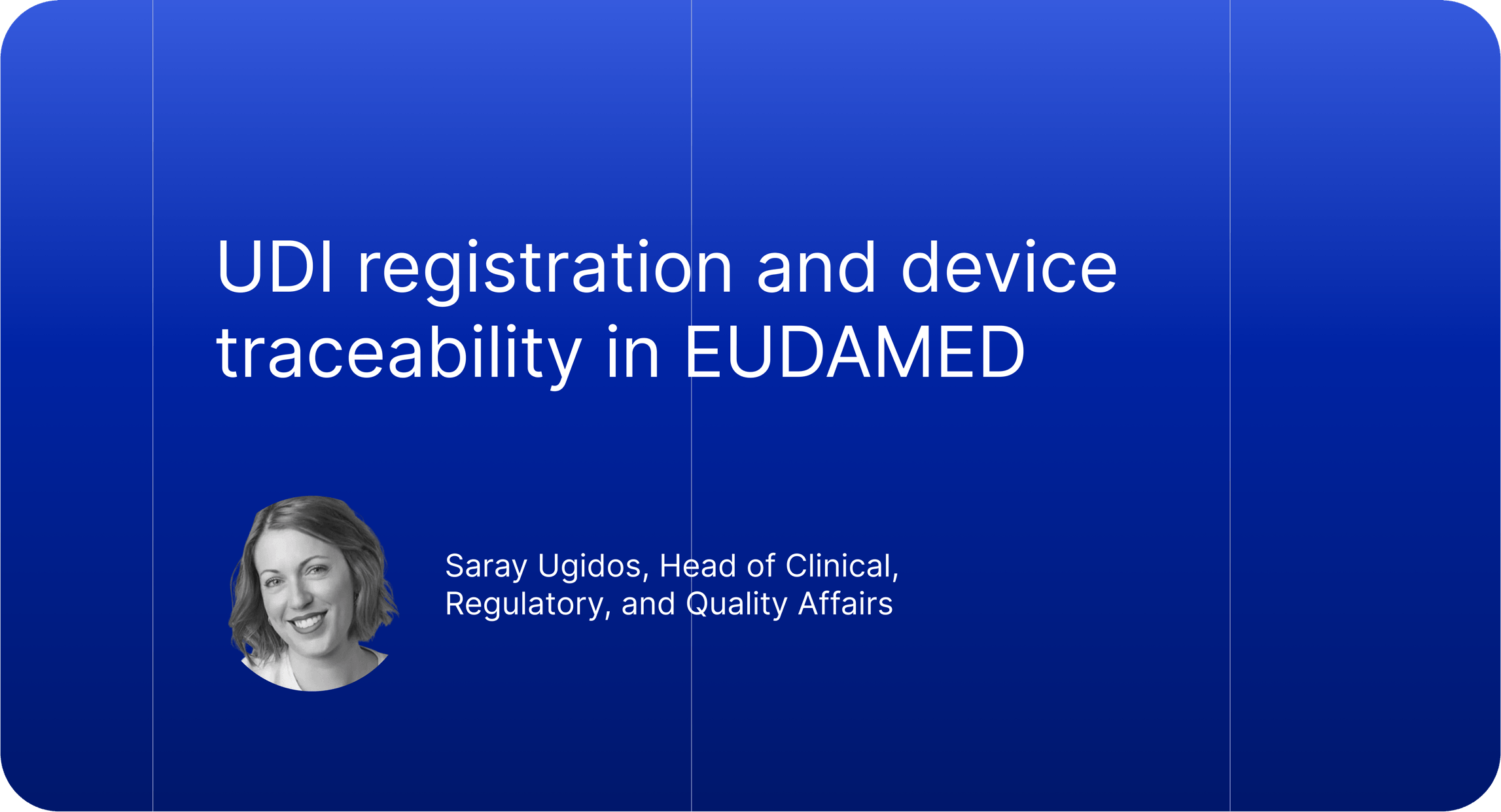Why UDI matters in the European market
Medical device companies today face an increasingly demanding regulatory environment in Europe. With the full enforcement of the Medical Device Regulation (MDR 2017/745) and the In Vitro Diagnostic Regulation (IVDR 2017/746), one topic has risen to the top of every compliance agenda: UDI registration and device traceability. These requirements, embedded within the European Database on Medical Devices (EUDAMED), are not optional. They determine whether a device can enter and remain on the market, and they directly influence patient safety and trust in healthcare systems.
Understanding EUDAMED
EUDAMED is a centralized database established by the European Commission to unify and standardize regulatory information across all EU Member States. Previously, each country maintained its own registry with different formats and levels of accessibility. This fragmentation created inefficiencies and left gaps in oversight. EUDAMED addresses these issues by providing a single structured platform that regulators, manufacturers, healthcare providers, and, in some cases, the public can rely on.
The database is composed of six interconnected modules. These include actor registration, device registration through UDI, notified bodies and certificates, clinical investigations and performance studies, vigilance and post-market surveillance, and market surveillance.
Together, they create a holistic picture of medical device activity in the European Union.
The foundation of UDI
The Unique Device Identification system assigns each device a code that functions like a digital fingerprint. It consists of two parts. The first is the device identifier, or UDI-DI, which is fixed and links a specific model or version of a device to its manufacturer. The second is the production identifier, or UDI-PI, which is variable and can include the batch number, serial number, manufacturing date, or expiration date.
By combining these elements, each unit of a medical device can be uniquely identified and traced across its entire lifecycle.
How traceability strengthens patient safety
Traceability through UDI is not an abstract concept; it is a tangible reality. It has direct, measurable effects on patient safety and healthcare quality. When a defect is discovered, regulators and manufacturers can quickly pinpoint the affected batches and remove them from the market. This prevents unnecessary disruptions and ensures that unaffected devices remain available. Counterfeit products can also be detected and eliminated, since authenticity can be verified against the official data stored in EUDAMED.
UDI registration improves post-market surveillance. Adverse event reports can be linked to specific devices, enabling more accurate assessments of performance and risk. Over time, this creates a feedback loop that strengthens product development and regulatory oversight. Hospitals and clinics also benefit.
They can use UDI information to manage inventories, reduce errors in procurement, and ensure that the right devices are available for patient care.
Regulatory deadlines every manufacturer must know
The EU has established clear timelines for UDI registration. From the first of January 2026, every new device placed on the market must be registered immediately in EUDAMED. By the first of July 2026, all legacy devices that continue to be marketed must also be registered. While custom-made devices and investigational devices are exempt, they remain subject to separate notification protocols. Missing these deadlines is not an option. Non-compliance may invalidate CE marking, block access to the market, and expose companies to sanctions.
Data quality as the key to compliance
EUDAMED requires submissions of the highest data quality. Every field must be accurate, validated, and consistent with MDR and IVDR requirements. Device classification must align with the correct rules. Manufacturer and authorized representative details must be precise. Certificates and conformity assessment information must match technical documentation. Submissions with errors are rejected, leading to delays and potential compliance risks.
For companies that also operate in the United States, harmonization with the FDA’s Global Unique Device Identification Database, or GUDID, provides efficiencies. Many of the data elements overlap, allowing companies to adapt existing information to the European framework. However, careful mapping is needed to ensure compatibility.
The step-by-step process of UDI registration
The journey begins with actor registration. A manufacturer or authorized representative must first create an organizational profile in EUDAMED and obtain a Single Registration Number. Only after this step can device information be submitted. Each device must be linked to its UDI-DI and supported with details such as trade names, catalog numbers, and model identifiers. Characteristics, including sterility, reusability, or software functionality, must be declared, alongside CE certificate references and contact details for adverse event reporting.
In some cases, notified bodies must validate the registration, particularly for higher-risk devices. In most cases, however, submissions are processed automatically. Once accepted, the information enters the EUDAMED database, where it becomes accessible to regulators, healthcare providers, and, in certain cases, the public.
From that point, the responsibility shifts to maintaining the information. Updates to device design, new safety concerns, or changes in certification must all be reflected promptly to keep the data accurate.
Preparing internally for UDI compliance
Meeting these requirements demands preparation. Companies need compliance teams who are trained in MDR, IVDR, UDI coding, and the workflows of EUDAMED. Every manufacturer must appoint a Person Responsible for Regulatory Compliance, known as the PRRC, who oversees data quality and acts as the main contact with regulators and notified bodies.
Strong internal data governance is essential. Device master data must be collected, validated, and maintained consistently. Many companies now invest in regulatory information management systems that automate submissions, flag errors, and provide dashboards for monitoring compliance. Engaging early with the EUDAMED test environment is also advisable.
By practicing submissions in a controlled setting, companies can identify obstacles and correct them before the real deadlines arrive.
Competitive advantages of early registration
While compliance is mandatory, companies that move early also gain competitive benefits. Early registration demonstrates transparency and builds trust with regulators, hospitals, and patients. It strengthens the brand’s reputation for quality. Operationally, it allows smoother recall management, more reliable post-market surveillance, and more efficient supply chains. For multinational companies, aligning UDI strategies across the EU and the US provides global consistency and reduces duplication of effort.
The evolving role of UDI in digital health
Healthcare is changing rapidly, with digital technologies playing a larger role every year. Software as a Medical Device, digital therapeutics, and connected devices now form part of the regulatory landscape. These products bring new challenges for traceability, since they can be updated, patched, and connected across networks.
The European Commission has already begun adapting UDI requirements to cover software versioning, cybersecurity markers, and interoperability features. This evolution positions EUDAMED not just as a compliance tool but as an essential part of the digital health ecosystem in Europe.
UDI as the language of transparency
UDI registration and device traceability in EUDAMED are not administrative exercises. They are pillars of patient safety, transparency, and innovation. They ensure that devices can be recalled quickly, that counterfeit products are eliminated, that adverse events are traced accurately, and that healthcare providers have reliable information.
The deadlines of 2026 are approaching, and the process of collecting, validating, and harmonizing data requires time. Companies that start early will avoid compliance risks and gain strategic advantages. Aura Health supports medical device and digital health innovators through every step of this process, from regulatory strategy and UDI data governance to clinical validation and market access.
Manufacturers who prepare now will not only comply with MDR and IVDR. They will also demonstrate leadership, earn trust, and contribute to a safer and more transparent European healthcare system.

